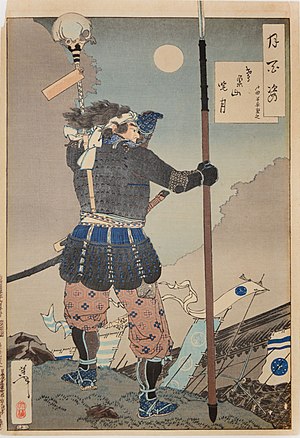Battle of Nagashino
| Battle of Nagashino | |||||||
|---|---|---|---|---|---|---|---|
| Part of the Sengoku period | |||||||
 General launching his troops to attack the castle of Nagashino in 1575, by Yoshitoshi |
|||||||
|
|||||||
| Belligerents | |||||||
| forces of Takeda Katsuyori | forces of Oda Nobunaga and Tokugawa Ieyasu | ||||||
| Commanders and leaders | |||||||
| Strength | |||||||
| 15,000 | 38,000 | ||||||
| Casualties and losses | |||||||
|
|
||||||
The Battle of Nagashino (長篠の戦い Nagashino no Tatakai?) took place in 1575 near Nagashino Castle on the plain of Shitaragahara in the Mikawa Province of Japan. Forces under Takeda Katsuyori had besieged the castle since the 17 June; Okudaira Sadamasa, a Tokugawa vassal, commanded the defending force. The Takeda forces attacked the castle because it threatened Takeda's supply lines.
Both Tokugawa Ieyasu and Oda Nobunaga sent troops to assist Sadamasa and break the siege, and their combined forces defeated Katsuyori. Nobunaga's skillful use of firearms to defeat Takeda's cavalry tactics is often cited as a turning point in Japanese warfare; many cite it as the first "modern" Japanese battle. In fact, the cavalry charge had been introduced only a generation earlier by Katsuyori's father, Takeda Shingen. Furthermore, firearms had already been used in other battles. Nobunaga's innovation was the wooden stockades and rotating volleys of fire which led to a decisive victory at Nagashino.
According to the Shinchō kōki, Nobunaga and Ieyasu brought a total force of 38,000 men to relieve the siege on the castle by Katsuyori. Of Takeda's original 15,000 besiegers, only 12,000 faced the Oda-Tokugawa army in this battle. The remaining 3000 continued the siege to prevent the garrison in the castle from sallying forth and joining the battle. Oda and Tokugawa positioned their men across the plain from the castle, behind the Rengogawa, a small stream whose steep banks would slow down the cavalry charges for which the Takeda clan was known.
Seeking to protect his arquebusiers, which he would later become famous for, Nobunaga built a number of wooden palisades in a zig-zag pattern, setting up his gunners to attack the Takeda cavalry in volleys. The stockades served to blunt the force of charging cavalry, provide protection from sword blows and spear thrusts, and provide limited protection from arrows. Ports or gates in the staggered and overlapping stockades were positioned to channel the cavalry charges into lanes where they would be vulnerable to further gunfire, arrows and sword and spear thrusts from the stockade's defenders.
...
Wikipedia
